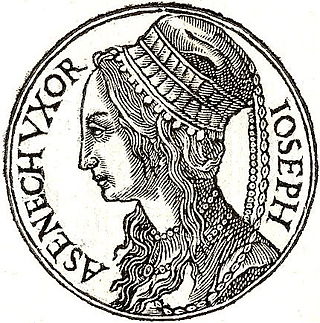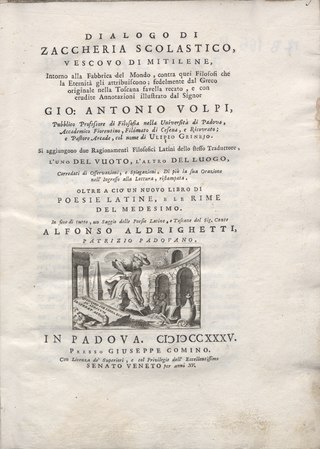Related Research Articles

The Peshitta is the standard version of the Bible for churches in the Syriac tradition, including the Maronite Church, the Chaldean Catholic Church, the Syriac Catholic Church, the Syriac Orthodox Church, the Malankara Orthodox Syrian Church, the Malabar Independent Syrian Church, the Syro-Malankara Catholic Church, the Assyrian Church of the East and the Syro-Malabar Church.

Asenath is a minor figure in the Book of Genesis. Asenath was a high-born, aristocratic Egyptian woman. She was the wife of Joseph and the mother of his sons, Manasseh and Ephraim.

Joseph and Aseneth is a narrative that dates from between 200 BCE and 200 CE. It concerns the Hebrew patriarch Joseph and his marriage to Asenath, expanding the fleeting mentions of their relationship in the Book of Genesis. The text was translated widely, including into Amharic, Arabic, Armenian, Early Modern German, Latin, Middle English, Old French, Romanian, Serbian and Syriac.

The Alexander Romance is an account of the life and exploits of Alexander the Great. Although constructed around a historical core, the romance is mostly fictional. It was widely copied and translated, accruing various legends and fantastical elements at different stages. The original version was composed in Ancient Greek some time before 338 CE, when a Latin translation was made, although the exact date is unknown. Several late manuscripts attribute the work to Alexander's court historian Callisthenes, but Callisthenes died before Alexander and therefore could not have written a full account of his life. The unknown author is still sometimes known as Pseudo-Callisthenes.
The Jesus bloodline refers to the proposition that a lineal sequence of the historical Jesus has persisted, possibly to the present time. The claims frequently describe Jesus as having married, often to Mary Magdalene, and as having descendants living in Europe, especially France but also the UK. Differing and contradictory Jesus progeny scenarios, as well as more limited claims that Jesus married and had children, have been proposed in numerous modern books. Some such claims have suggested that Jesus survived the crucifixion and went to another location such as France, India or Japan.
Barrie A. Wilson is Professor Emeritus and Senior Scholar, Humanities and Religious Studies, York University, Toronto, where he has taught since 1974. An historian of religion, he specializes in movements in early Christianity. Throughout the 1990s he was Chair, Religious Studies, Atkinson College, York University. From 1969 to 1974 he taught Ancient Philosophy and Logic at Saint Louis University in St. Louis, Missouri.
Moses bar Kepha or Moses bar Cephas was a writer and one of the most celebrated bishops of the Syriac Orthodox Church of the ninth century.

The Church History of Eusebius, the bishop of Caesarea was a 4th-century pioneer work giving a chronological account of the development of Early Christianity from the 1st century to the 4th century. It was written in Koine Greek, and survives also in Latin, Syriac and Armenian manuscripts.

Zacharias of Mytilene, also known as Zacharias Scholasticus or Zacharias Rhetor, was a bishop and ecclesiastical historian.

The Ordinalia are three medieval mystery plays dating to the late fourteenth century, written primarily in Middle Cornish, with stage directions in Latin. The three plays are Origo Mundi, Passio Christi and Resurrexio Domini. The metres of these plays are various arrangements of seven- and four-syllabled lines. Ordinalia means "prompt" or "service book".

Syriac is a dialect of Aramaic. Portions of the Old Testament were written in Aramaic and there are Aramaic phrases in the New Testament. Syriac translations of the New Testament were among the first and date from the 2nd century. The whole Bible was translated by the 5th century. Besides Syriac, there are Bible translations into other Aramaic dialects.
British Library, Add MS 14459, Syriac manuscript of the New Testament, on a parchment. It is dated by a colophon to the year 528-529 or 537-538. It is one of the oldest manuscript of Peshitta and the earliest dated manuscript containing two of the Gospels in Syriac. The manuscript is bound with another dated to the 5th century.
British Library, Add MS 14669, Syriac manuscript of the New Testament, according to the Peshitta version, on parchment. Palaeographically it has been assigned to the 6th century. It contains fragments of the Gospels.
British Library, Add MS 12150 is the second oldest extant Syriac manuscript and the oldest codex bearing a date in any language.
The Crawford Aramaic New Testament manuscript is a 12th-century Aramaic manuscript containing 27 books of the New Testament. This manuscript is notable because its final book, the Book of Revelation, is the sole surviving manuscript of any Aramaic version of the otherwise missing Book of Revelation from the Peshitta Syriac New Testament. Five books were translated into Syriac later for the Harklean New Testament.

Infancy gospels are a genre of religious texts that arose in the 2nd century. They are part of New Testament apocrypha, and provide accounts of the birth and early life of Jesus. The texts are of various and uncertain origin, and are generally non-canonical in major modern branches of Christianity. They include the Gospel of James, which introduces the concept of the Perpetual Virginity of Mary, and the Infancy Gospel of Thomas, both of which cover many miraculous incidents from the life of Mary and the childhood of Jesus that are not included in the canonical gospels. Although the Life of John the Baptist focuses on John the Baptist rather than Jesus or his immediate family, it is also included in the genre as its events would be contemporary with Jesus's early life.

The Lost Gospel: Decoding the Ancient Text that Reveals Jesus' Marriage to Mary the Magdalene is a book published by investigative journalist Simcha Jacobovici and Religious Studies historian Barrie Wilson in 2014. It contends that the 6th century manuscript -- by Pseudo-Zacharias Rhetor now British Library Add MS 17202 -- commonly referred to as "Joseph and Aseneth" is really a disguised history. The book's assertions are not supported by mainstream Biblical scholarship.
Moses of Ingila was a Syriac Christian author who translated a number of texts from Greek into the Syriac language.
The Chronicle of 846 is a fragmentary universal chronicle written in Syriac by an anonymous author sometime between 846 and 873. Its focus for the later centuries, where it is most valuable, is ecclesiastical history. It is written from a Syriac Orthodox perspective.
The Melkite Chronicle or Chronicle of 641 is an anonymous world chronicle written in Syriac shortly after the death of the Emperor Heraclius in 641.
References
- ↑ Amir Harrak, "Zacharias, Pseudo-", in Gorgias Encyclopedic Dictionary of the Syriac Heritage: Electronic Edition, edited by Sebastian P. Brock, Aaron M. Butts, George A. Kiraz and Lucas Van Rompay. Consulted 24 July 2020.
- ↑ Hamilton F. J. and Brooks, E. W., eds., The Syriac chronicle known as that of Zachariah of Mitylene. London: Methuen, 1899.
- ↑ Simcha Jacobovici and Barrie Wilson, The Lost Gospel. New York: Pegasus, 2014.